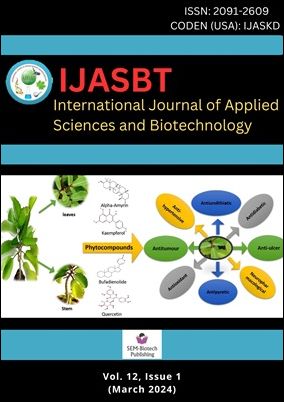Comparative Phytochemical Constituents of Extracts of Bryophyllum pinnatum Grown in Anambra State, Nigeria
DOI:
https://doi.org/10.3126/ijasbt.v12i1.64330Keywords:
Bryophyllum pinnatum, extraction, methanol, ethanol, aqueousAbstract
Bryophyllum pinnatum is a plant abundant in several phytochemicals, that can be extracted, purified, and packaged for the goal of promoting public health. In this study, the phytochemical composition of the leaf extracts of Bryophyllum pinnatum grown in Anambra State, Nigeria, was compared. B. pinnatum leaves were obtained from a farm in Anambra State, Nigeria. The leaves were processed and extracted using cold water and hot water extraction, methanol extraction, and ethanol extraction. The extraction processes were carried out following standard extraction methods. Preliminary qualitative and quantitative analyses were conducted to determine the presence and concentration of phytochemicals in the plants. Phytochemicals tested include alkaloids, flavonoids, saponins, tannins, anthocyanins, reducing sugars, carbohydrates, proteins, cardiac glycosides, terpenoids, and phlobatannins. All the tested phytochemicals were recovered in the solvent (methanol and ethanol) extracts; carbohydrates, reducing sugar, protein, and anthocyanin were absent in the aqueous (cold and hot water) extracts. Varying concentrations of the phytochemicals in the different extracts were recorded, and they range from 0.00±0.00% to 13.30±0.22%, with the highest concentration of the extracts recovered in the solvent (methanol and ethanol) extracts. This study revealed that the extraction method used can influence the type and concentration of phytochemicals recovered in Bryophyllum pinnatum. Therefore, the specific desired phytochemical should determine the extract method to use in any study.
Int. J. Appl. Sci. Biotechnol. Vol 12(1): 1-7.
Downloads
Downloads
Published
Versions
- 2024-04-11 (2)
- 2024-03-31 (1)
How to Cite
Issue
Section
License
Copyright (c) 2024 International Journal of Applied Sciences and Biotechnology

This work is licensed under a Creative Commons Attribution-NonCommercial 4.0 International License.




